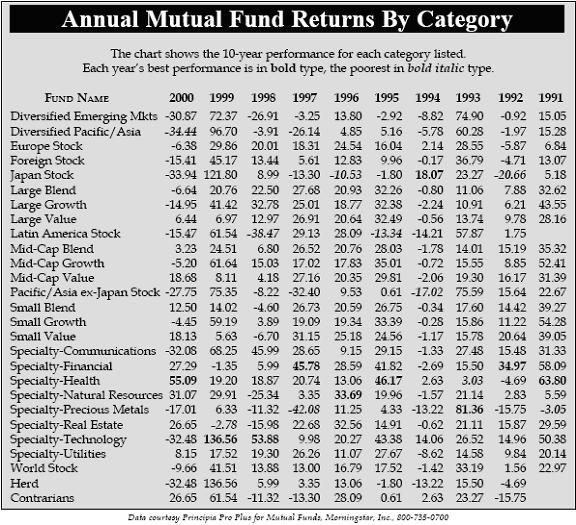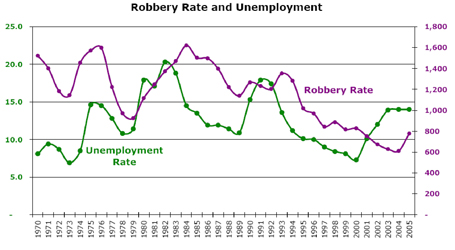Recently, many personal finance magazines came out with their “Best Funds for 2002” issues. These publications want you to believe that they can predict which mutual funds will be extraordinary this year. I doubt this is possible.
Investment publications and, for that matter, investment gurus love to make stock market predictions. It is, after all, exciting. It sells magazines and keeps investors coming back for more strategies that might outperform their neighbors’. Unfortunately, as I’ve learned through experience, accurate predictions generally reflect luck rather than skill.
Analyzing a chart I developed with the help of the Morningstar mutual funds database, I tried to identify a pattern in annual mutual fund category returns. Did 1995’s winner repeat in 1996? Or did 1995’s loser win big in 1996? Or perhaps the pattern of mutual fund performance is random?
Many investors like to bet on last year’s winners. They buy last year’s best-performing funds in the hopes that the investment trend will continue. They are often referred to as performance-chasers or, simply, the herd. Other investors who deem themselves more sophisticated prefer to bet against the herd. They buy last year’s worst-performing mutual funds in the hopes of a turnaround. I will refer to them as contrarians.
To test how well these strategies work, I conducted a hypothetical fund derby from 1992 through 2000. The contestants were the herd, the contrarians and a diversified portfolio.
The chart above displays average annual returns of equity funds in Morningstar’s database sorted by category. In my derby, the herd chose the previous year’s best-performing Morningstar category as its annual investment selection. For example, that category in 1991 was the Specialty-Health category. Therefore, the herd chose the Specialty-Health category for its 1992 bet. In 1992, the herd’s performance was -4.7%, the return for the Specialty-Health category. The Specialty-Financial category turned out to be the best-performing Morningstar category in 1992. It became the herd’s 1993 pick, providing a return of 15.5%. I continued this process through 2000. The annualized performance of this strategy was 7.1%.
The contrarians, always betting against the grain, chose the previous year’s worst-performing Morningstar category as their annual investment selection. The worst-performing category in 1991 was Specialty-Precious Metals. Therefore, the contrarians chose Specialty-Precious Metals for their 1992 bet. In 1992, the contrarians’ performance was -15.75%, the return for the Specialty-Precious Metals category. The Japan Stock category turned out to be the worst-performing Morningstar category in 1992. In 1993, the contrarians’ return was 23.3%, the performance of the Japan Stock category. Like before, I continued this process through 2000. The annualized performance of this strategy was 8.9%.
The control investment in the derby was a diversified portfolio. I used the World Stock category as the proxy for a diversified portfolio. The World Stock category encompasses U.S. and international stocks spread across a balance of small-, mid- and large-cap stocks divided into many different sectors. The annualized performance of this strategy from 1992 through 2000 was 13%.
Table For Two?
If a contrarian happened to be dining at the technology stock table in 1998, he sold his mutual funds after that year’s 54% return. That proved to be only the appetizer, though, because the herd enjoyed a wonderful entree during 1999’s 137% rise in technology stocks. But tech stocks dropped 32% in 2000 and another 47% in the 10 months ended October 31, 2001.
Like clockwork, one year’s best-performing funds attract more than their proportionate share of new cash. Unfortunately, most of the fund’s out-performance has already been achieved, a phenomenon studied by the Financial Research Corporation (FRC). The FRC concluded that, on average, 14 times as much new money flowed into funds after their best-performing quarters as new cash flowed into funds after their worst-performing quarters. Further, they concluded that over rolling periods between January 1990 and March 2000, the average mutual fund’s mean three-year return was 10.9%, while the average investor gained only 8.7% over the same period. On average, the herd arrives late and does not experience exceptional, or even average, performance.
Yet investors continue to flock toward funds that they think will lead to extraordinary performance. The difficulty with any prediction theory is that some investment cycles last for years, while others last for only months. No one, to my knowledge, has been successful at consistently timing the beginning and end of cycles. Investment cycles are random and patterns do not exist.
So, where does that lead investors who want favorable results? It leads to the dull, yet effective, theory that we use at Palisades Hudson Asset Management, Inc. — asset class diversification. Ultimately, you’ll always have some winners and always have some losers in a diversified portfolio. It may not be exciting, but it’s the tried-and-true method for achieving realistic investment goals.









